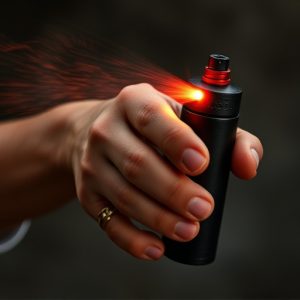Crowd Control Pepper Spray: Science, Safety, & Future Innovations
Crowd control pepper spray techniques have evolved dramatically thanks to advancements in chemical i…….
Crowd control pepper spray techniques have evolved dramatically thanks to advancements in chemical irritant science, particularly capsaicin, which causes burning sensations and temporary blindness upon contact. These tactics are employed as a last resort after exhausting non-lethal methods, with proper training crucial for effective and safe deployment. Global regulations vary but generally focus on balancing public safety and potential risks through strict standards, training programs, and equipment testing. Future innovations aim to enhance safety, effectiveness, and minimize environmental impact, including eco-friendly formulations, improved delivery systems, and smart sensors for real-time crowd behavior monitoring.
“In the realm of personal protection, crowd control pepper spray techniques have emerged as a powerful tool. This article delves into the science behind chemical irritants, specifically focusing on pepper spray. We explore its role in crowd control through effective use cases and best practices. Furthermore, it examines the design and considerations for Personal Protection Devices (PPDs), highlighting regulatory frameworks and safety measures. Lastly, we discuss future trends, including innovations in crowd control pepper spray technologies.”
- Understanding Chemical Irritants: The Science Behind Pepper Spray
- Crowd Control Techniques: Effective Use Cases and Best Practices
- Personal Protection Devices (PPDs): Design and Considerations for Optimal Performance
- Regulatory Frameworks and Safety Measures for Chemical Irritant Usage
- Future Trends: Innovations in Crowd Control Pepper Spray Technologies
Understanding Chemical Irritants: The Science Behind Pepper Spray
Chemical irritants, particularly crowd control pepper spray, have become integral to personal protection devices in various scenarios, from law enforcement to self-defense. Understanding the science behind these substances offers insight into their effectiveness and safety considerations. Pepper spray, a common type of chemical irritant, contains capsaicin, the active ingredient found in chili peppers. When sprayed, it activates sensory nerve endings, causing a burning sensation and temporary blindness, which aids in crowd control techniques by disrupting and disorienting individuals.
The mechanism of action involves the binding of capsaicin to specific receptors in the eyes and respiratory system, leading to inflammation and discomfort. This reaction allows users to maintain control during high-stress situations, such as when managing large crowds or responding to threats. The scientific understanding of chemical irritants like pepper spray has led to advancements in formulation, delivery systems, and safety protocols, ensuring their responsible use for personal protection while mitigating risks associated with exposure.
Crowd Control Techniques: Effective Use Cases and Best Practices
Crowd control pepper spray techniques have proven to be highly effective in various scenarios, from large public events to law enforcement operations. When deployed strategically, crowd control pepper spray can swiftly disrupt and disperse crowds, providing critical time for security personnel to maintain order or evacuate areas. For instance, at concerts or sports events, where large gatherings can quickly turn chaotic, a single tactical application of pepper spray can send people scattering, allowing organizers to manage the situation efficiently.
Best practices dictate that crowd control pepper spray should be used as a last resort and only when other non-lethal methods have been exhausted. Training is paramount; officers or security personnel must learn proper usage techniques to ensure accuracy and minimize off-target effects. Additionally, maintaining a safe distance and considering environmental factors like wind direction are essential for effective crowd control. Regular maintenance and updates on equipment also guarantee that pepper spray remains potent and ready for deployment when needed.
Personal Protection Devices (PPDs): Design and Considerations for Optimal Performance
Personal Protection Devices (PPDs) are designed to safeguard individuals in various high-risk scenarios, including crowd control situations. When it comes to crowd control pepper spray techniques, PPDs play a pivotal role in ensuring the safety of both the enforcers and the public. The design considerations for these devices go beyond mere functionality; they involve intricate engineering to balance effectiveness, user comfort, and ease of deployment.
One key aspect is the selection of appropriate chemical irritants. Crowd control pepper spray, for instance, utilizes capsaicin, a compound derived from chili peppers, to create a disabling effect without causing permanent harm. The concentration and delivery mechanism are crucial; a well-designed PPD will have precise controls to administer the spray accurately, minimizing off-target effects and ensuring optimal performance in chaotic crowd scenarios. Additionally, factors like weight, grip, and durable construction contribute to the overall effectiveness of PPDs during crowd control operations, where swift and reliable deployment can be the difference between maintaining order and escalating violence.
Regulatory Frameworks and Safety Measures for Chemical Irritant Usage
The regulatory frameworks governing the use of chemical irritants, such as crowd control pepper spray techniques, vary significantly across regions. These regulations are designed to balance public safety with the potential risks associated with these substances. In many countries, the production, distribution, and deployment of chemical irritants are strictly controlled by specialized agencies that monitor adherence to safety standards. This includes stringent guidelines on labeling, storage, and disposal to prevent accidental exposure or misuse.
Safety measures for chemical irritant usage include comprehensive training programs for law enforcement officers and security personnel to ensure they employ these techniques responsibly. This involves understanding the unique properties of different chemical irritants, their impact on human health, and the appropriate response in case of exposure. Additionally, regular testing and maintenance of equipment, such as spray devices, are crucial to guarantee their effectiveness while minimizing risks to both users and bystanders.
Future Trends: Innovations in Crowd Control Pepper Spray Technologies
The future of crowd control pepper spray technologies looks promising, with innovations focused on enhancing safety and effectiveness while minimizing environmental impact. Researchers are exploring more eco-friendly formulations that still maintain their potency, aiming to reduce the ecological footprint associated with traditional pepper spray use. Additionally, advancements in delivery systems, such as improved nozzle designs and advanced actuation mechanisms, promise better accuracy and reduced chances of accidental activation.
These developments aim to make crowd control pepper spray techniques more precise, ensuring that law enforcement officers can target specific individuals without affecting bystanders. Furthermore, the integration of smart sensors and technology enables real-time monitoring and analysis of crowd behavior, allowing for proactive crowd control measures. These future trends signal a step towards safer and more efficient crowd management strategies, leveraging technological innovations to strike a balance between public safety and environmental sustainability.
Crowd control pepper spray, as a powerful tool in public safety, continues to evolve through advanced scientific understanding and innovative technology. By examining the chemistry behind irritants, refining crowd control techniques, enhancing personal protection devices, and adhering to strict regulatory guidelines, we can ensure optimal effectiveness while mitigating risks. Future developments promising improved formulations and delivery systems underscore the ongoing commitment to enhancing public security through sophisticated crowd control pepper spray techniques.


